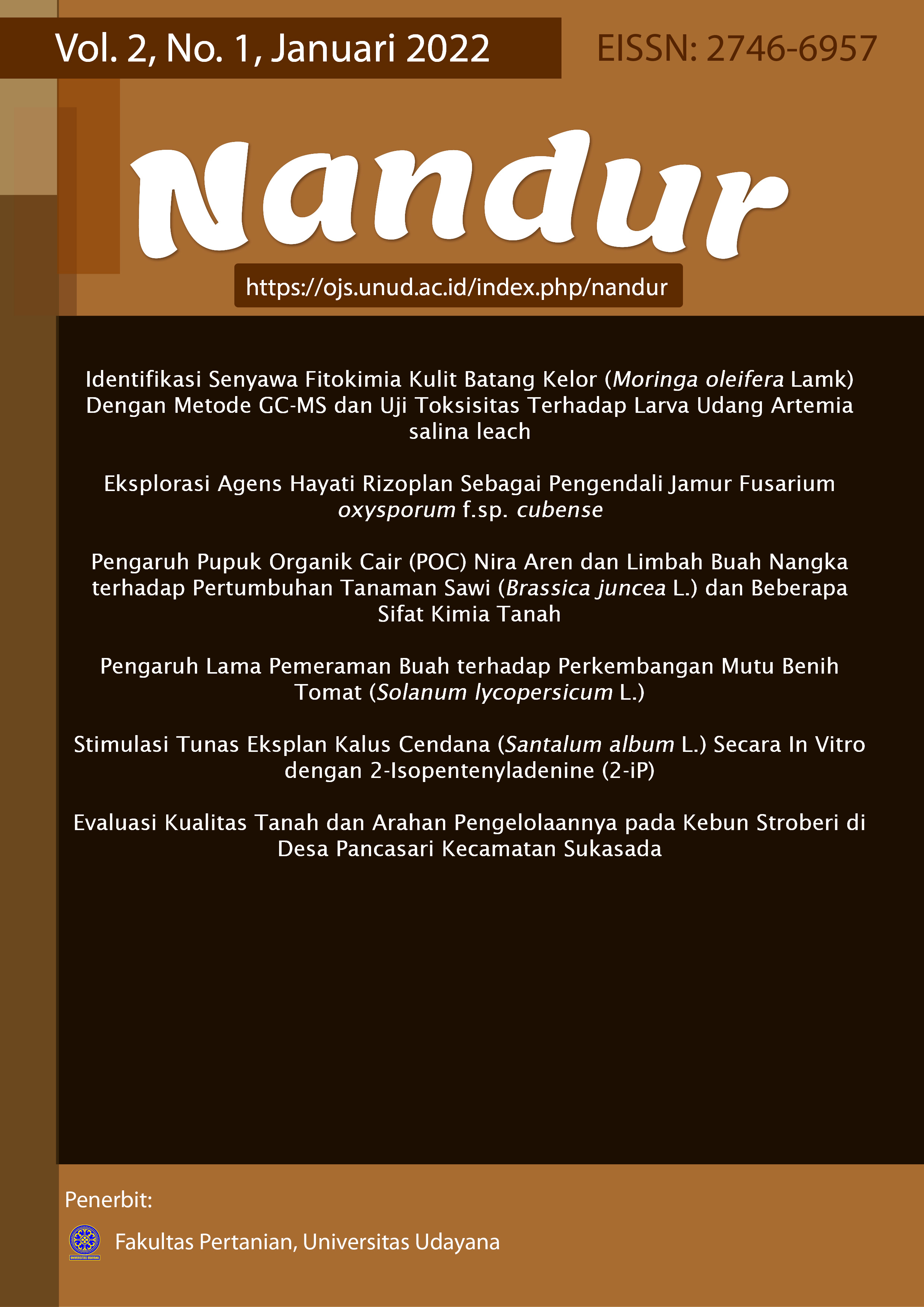Identifikasi Senyawa Fitokimia Kulit Batang Kelor (Moringa oleifera Lamk) Dengan Metode GC-MS dan Uji Toksisitas Terhadap Larva Udang Artemia salina leach
Abstract
Kelor (Moringa oleifera) is a plant that grows in tropical climates including Indonesia. All parts of this plant can be used as medicine and other natural products. The purpose of this study was to determine the bioactive compounds contained in moringa stem bark and the level of toxicity expressed by an LC50 value of less than 1.000 ppm so that it can be used as traditional medicine and other natural products. Identification of bioactive compounds in moringa stem bark using the GC-MS analysis method and toxicity test on Artemia salina Leach shrimp larvae using the Brine Shrimp Lethality Test (BSLT) method. Based on the results of the analysis using GC-MS showed that moringa bark extract contains 14 bioactive compounds. The highest bioactive compounds in the 3 peaks were secondary metabolites in the form of phenols and monoterpenoids. The toxicity test of moringa bark extract against Artemia salina Leach larvae showed that the higher the concentration, the higher the percentage of mortality of Artemia salina Leach, so that the calculated LC50 value of moringa bark extract was toxic, which was 149,689 ppm.
References
Jonni, M.S. (2008). Cegah Malnutrisi dengan Kelor. Penerbit Kanisius. Yogyakarta. Hal. 13-93.
Jack. (2006). Synthesis of Antidiabetic Flavonoids and Their Derivative. Medical Research. Page. 180.
Meyer, B.N., N.R. Feerigni, J.E. Putnam, L.B. Jacobson, D.E. Nicholas, J.L. McLaughlin. (1982). Brine shrimp a convenient general bioassay for active plant constituents. Plant Med. Vol. 45:31-34.
Miwa, K.,T. Miyashita, K. Oyama, T. Ohta, and T. Fujimura. (2006). Role of Cyclooxygenase-2 in the Carcinogenesis of gastrointestinal track cancer; A Review and Report of Journal of Gastroenterology. 12(9) : 1336-1345.
Muaja, A. D., H.S.J. Koleangan, dan M.R.J. Runtuwene. (2013). Uji toksisitas dengan metode BSLT dan analisis kandungan fitokimia ekstrak daun sayogik (Saurauia bracteosa) dengan metode soxhletasi. Jurnal MIPA. Unsrat. Vol 2 (2): 115-118
Nurhayati, N., Abdulgani, R. Febrianto. (2006). Uji toksisitas ekstrak Alvaresii terhadap Artemia salina Leach. sebagai studi pendahuluan potensi anti kanker. Skripsi. Program Studi Biologi FMIPA Institut Teknologi Sepuluh November. Surabaya. 1- 9.
Putriani, R.I.K.A. (2013). Skrining fitokimia dan aktivitas antioksidan ekstrak rumput laut Sargassum duplicatum dan Turbinaria ornata dari Jepara. Universitas Diponegoro. Semarang. 2 (1): 3-10.
Senja, R. S., E. Issusilaningtyas, A. K. Nugroho, dan E. P. Setyowati. (2014). The comparison of extraction method and solvent variation on yield and antioxidant activity of Brassica oleracea L. var. capitate f. rubra Extract. Traditional Medic Journal. 19 (1): 43-48.
Triodora, H., R. Ayik, O. Ika. (2016). Sintesis asam 2-(2-(n-(2,6-diklorofenil)-4fluorobenzamida) fenil) asetat sebagai kandidat obat penghambat COX (siklooksigenase). Fakultas Farmasi Universitas Jember. Kalimantan. Jember. 1 (1) : 1-10.
Toripah, S.S., J. Abidjulu, dan F. Wehantouw. (2014). Aktivitas antioksidan dan kandungan total fenolik ekstrak daun kelor (Moringa oleifera Lamk). Program Studi Farmasi FMIPA Universitas Samratulangi. Manado. Vol. 1(2): 6-9.



